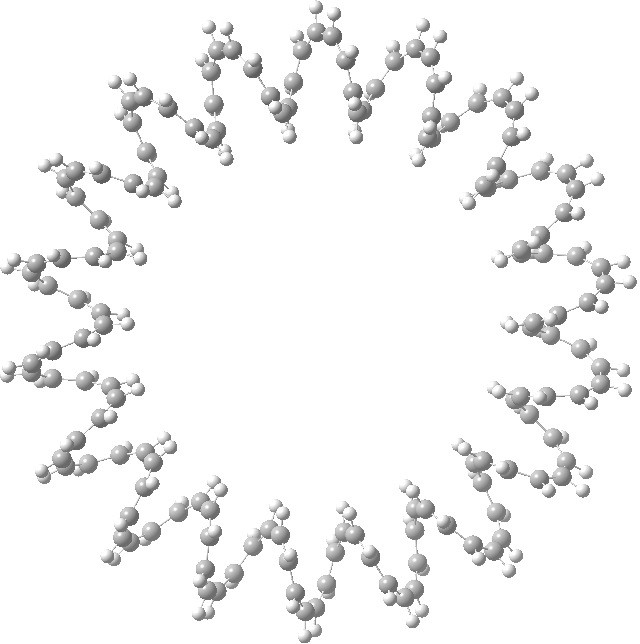This is a recently published[1] (hypothetical) molecule which has such unusual properties that I cannot resist sharing it with you. It is an annulene with 144 all-cis CH groups, being a (very) much larger cousin of (also hypothetical) systems mooted in 2009[2],[3].

A 144-carbon annulene. Click for 3D.
One fascinating novel aspect of Berger’s work is that he identifies that such helical systems will exhibit a distinct anapolar ring current structure in a constant and homogeneous magnetic field, perpendicular to the main molecular plane. Such anapolar magnetism is distinctly different from the dipolar (diatropic) ring currents normally associated with aromatic molecules, and with the current interest in the magnetic properties of graphene-like objects (see also this blog post and also the helical metal wire) such molecules can only help to excite our imaginations.
I also show one of the more stable molecular orbitals for the [144]-annulene (ωB97XD/6-31G(d,p) calculation).‡ Molecular art indeed!

MO 461. Click for 3D.
If you go to the Knotplot site, there you will find a torus link of form (2,18), which displays as the below. Look familiar? Notice the chirality is opposite however!
‡Orbitals for smaller rings with such form can be found here.
References
- R.J.F. Berger, "Prediction of a Cyclic Helical Oligoacetylene Showing Anapolar Ring Currents in the Magnetic Field", Zeitschrift für Naturforschung B, vol. 67, pp. 1127-1131, 2012. http://dx.doi.org/10.5560/ZNB.2012-0189
- S.M. Rappaport, and H.S. Rzepa, "Intrinsically Chiral Aromaticity. Rules Incorporating Linking Number, Twist, and Writhe for Higher-Twist Möbius Annulenes", Journal of the American Chemical Society, vol. 130, pp. 7613-7619, 2008. http://dx.doi.org/10.1021/ja710438j
- C.S. Wannere, H.S. Rzepa, B.C. Rinderspacher, A. Paul, C.S.M. Allan, H.F. Schaefer, and P.V.R. Schleyer, "The Geometry and Electronic Topology of Higher-Order Charged Möbius Annulenes", The Journal of Physical Chemistry A, vol. 113, pp. 11619-11629, 2009. http://dx.doi.org/10.1021/jp902176a
Tags: helical metal wire, helical systems, Interesting chemistry
